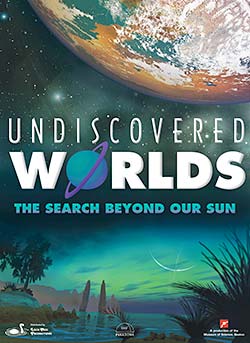Undiscovered Worlds: The Search Beyond Our Sun
Alien worlds — they're out there!
Humans have long imagined exotic and intriguing worlds beyond our solar system. However, in recent years, science fiction has become science fact. In Undiscovered Worlds: The Search Beyond Our Sun, you and your audiences can now see what our sophisticated telescopes and detection techniques are finding out there.
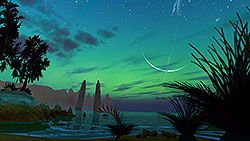 We now know that our Sun is not the only star with orbiting planets. Since the discovery of the first exoplanet in 1995, astronomers have found hundreds more orbiting other stars in our galaxy and beyond. What are they like? Undiscovered Worlds: The Search Beyond Our Sun takes you there to find out!
We now know that our Sun is not the only star with orbiting planets. Since the discovery of the first exoplanet in 1995, astronomers have found hundreds more orbiting other stars in our galaxy and beyond. What are they like? Undiscovered Worlds: The Search Beyond Our Sun takes you there to find out!
Our journey begins on a starlit beach, but the coming dawn reveals that this is no ordinary beach. We see a world with unfamiliar plant life and landscapes, as well as an alien sky. Are Earth-like planets like this common or unique in our universe?
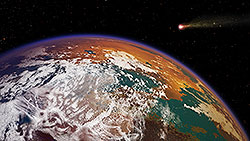 To find out, we go to a star very similar to our Sun: 51 Pegasi. As a great shadow passes in front of the star, a giant exoplanet orbits nearby. It's unlike anything in our solar system: more than a hundred times as massive as the Earth but is extremely close to its star.
To find out, we go to a star very similar to our Sun: 51 Pegasi. As a great shadow passes in front of the star, a giant exoplanet orbits nearby. It's unlike anything in our solar system: more than a hundred times as massive as the Earth but is extremely close to its star.
To understand how unusual this system is, we look at our own solar system as it formed some 4.5 billion years ago, resulting in small rocky planets close to the Sun and gas giants farther away. Since astronomers are now finding exoplanets that do not follow this same pattern, they are re-thinking our views of planetary mechanics and the dynamics of planetary formation.
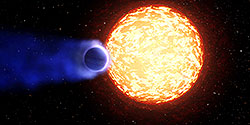 One of the most important goals in exoplanet studies is the search for a world capable of supporting life. We target rocky, terrestrial worlds because they are most similar to Earth, but they are not always hospitable to life. As the show takes us into the atmosphere of the exoplanet CoRoT-7b, we see that this planet is so close to its star that everything on the surface is molten. To find life, we must also look in the habitable zones of stars, where temperatures allow liquid water to be stable on the surface. Flying into the planetary system of Gliese 581, we see that one of its four planets is just inside the habitable zone. The show takes us for a visit to see just how like Earth it might be.
One of the most important goals in exoplanet studies is the search for a world capable of supporting life. We target rocky, terrestrial worlds because they are most similar to Earth, but they are not always hospitable to life. As the show takes us into the atmosphere of the exoplanet CoRoT-7b, we see that this planet is so close to its star that everything on the surface is molten. To find life, we must also look in the habitable zones of stars, where temperatures allow liquid water to be stable on the surface. Flying into the planetary system of Gliese 581, we see that one of its four planets is just inside the habitable zone. The show takes us for a visit to see just how like Earth it might be.
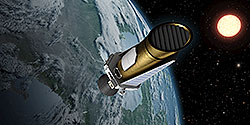 One of our most powerful tools in the search for Earth-like worlds is the Kepler telescope. This amazing space-based observatory, launched in 2009, intently watched more than 100,000 stars in the hopes of observing exoplanets transiting their stars. From the faint dimming of starlight as they passed, astronomers learned many things about those distant worlds. The results from Kepler have changed our view of extrasolar planets, and are shaping our understanding of how planetary systems form. Ultimately, what we learn from Kepler will help us see how common or rare planets like Earth may be in the universe.
One of our most powerful tools in the search for Earth-like worlds is the Kepler telescope. This amazing space-based observatory, launched in 2009, intently watched more than 100,000 stars in the hopes of observing exoplanets transiting their stars. From the faint dimming of starlight as they passed, astronomers learned many things about those distant worlds. The results from Kepler have changed our view of extrasolar planets, and are shaping our understanding of how planetary systems form. Ultimately, what we learn from Kepler will help us see how common or rare planets like Earth may be in the universe.
Undiscovered Worlds: The Search Beyond Our Sun ends on a starlit beach on Earth, and reminds us that whatever we find "out there", human existence is just one tiny grain of sand on the beach of the cosmic sea. The universe is incredibly old and large, and humans have only been around for a very short time, making incredible discoveries.
We're pleased to offer Undiscovered Worlds: The Search Beyond Our Sun to you and your audiences for your own exoplanet explorations!

Running time: 30 minutes (24 minute version available)
Suitable for: General Public
Information about: Extrasolar planets, solar system, Kepler Space Telescope.
Year of production: 2010
None yet!
Don't see the language you want? Let's work together with the producer to create it. Read more here!
Educators — looking classroom activities and educational standards descriptions for this show? Download the Museum of Science's useful Educator's Guide.



